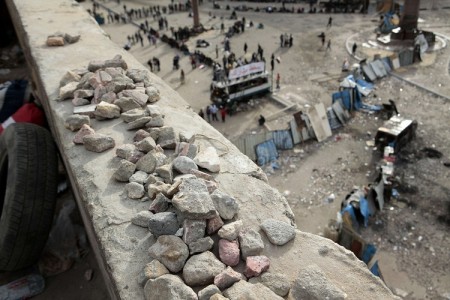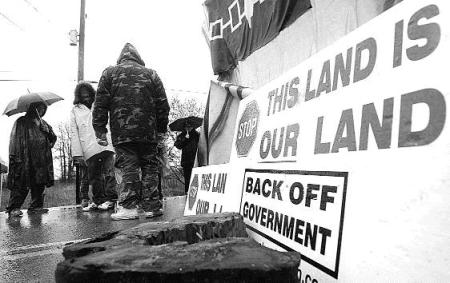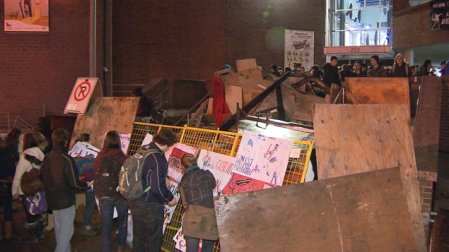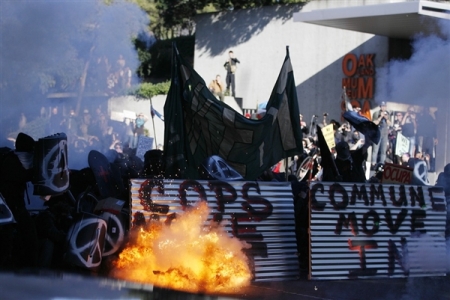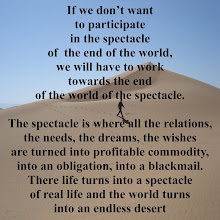Tuesday, July 31, 2012
"Elements of a Barricade" by Moments of Isurrection
Myth of the Barricade:
The barricade is the myth of insurrection. To look back at past revolt is to reflect on the use of barricades. To see struggle today is to watch the burning barricades of the Paris banlieues, the walls of flame in Athens, the camp fires of the Native roadblock. A barricade consciousness was born in myth and spread as a symbol.
Anticipation of the future takes the form of those myths which enclose the strongest inclinations, which occur in the mind with the insistence of instincts in all circumstances of life; and which gives an aspect of complete reality in the hopes of immediate action.
The myth of the barricade is a body of images capable of invoking instinctively, all the sentiments which correspond to the different manifestations of social rebellion.
As a symbol it has transmitted through centuries of defeat but still retains its redemptive agency. At the barricade, present struggles need not be overloaded with prior sufferings but leap back and grasp a past moment of insurrection, to give it new life and achieve today what once failed. It is within the potentiality carried in every moment that every insurgent barricade awaits its return.
From riot to insurrection the barricade is a constant. In the first awakening moments of the riot, the barricade appears immediately, made from dumpsters, torched cars, rubble, prison mattresses –whatever is at hand. Often the style of the barricade projects the trajectory of the riot.
Barricades of adaptation and diffusion can be instantly reproduced, even when decades have eclipsed since their last appearance. They are a template to enable, with minimal discourse or organizational continuity, coordinated points of rupture. These elements constitute the barricade consciousness.
Insurgent-Assemblage:
The barricade made of single objects working in cooperation with one another operates as an assemblage. The characteristics of the barricade-assemblage are the flowing, breaks and swerves of its autonomous components. This is opposed to the closed connections of the state apparatus that regulates networks of power. The barricade assemblage corresponds to a tendency of permanent connection –it reaches outwards to establish an infinite plain of consistency. The barricade is a node of spreading revolt, communicating and connecting to other modes of struggle. It flows from one street (or forest road) to the next; when it is restricted, it goes underground and links up again in a rhizome. Finally the street engulfs the city, as on the land –the industrial ruins are re-wilded.
Following the Barricade Wars of 1848 which swept Europe, the streets of Paris and other major city’s where demolished and replaced with vast boulevards, so as to prevent the use of barricades in future combat. At this time even Blanqui called for an end of the insurgent barricade claiming that they where stupid and a waste of time as they prevented the free movement of insurgents. A short while later in 1871, in a great leap forward for the adaptability of barricade consciousness, the barricades of the Paris Commune traversed the street to occupy the whole city.
The barricade fighting that took place during the Commune was fought more from the windows above in the buildings connected to the barricades. The barricade became the tissue that interconnected the street to the fighter to all structures.
The insurgent with their projectile constitutes a war machine under the conditions of the barricade: functioning as a component part in conjunction with other parts. In this, the insurgent barricade rejects any closed-circuit specificities and instead opens itself to a pure means, which demands nothing and occupy’s everything. There the rebel-subjects integrated with the barricade, in both myth and structure –intermingle as singularities in becoming…whatever.
‘Elsewhere, behind the hastily improvised barricades erected and set alight by local kids in back streets they prepare to greet their daily enemy – the cops in their anti-riot vans – with a hail of bottles and stones…’ August 2011 Revolt: Anarchy in the UK
Solidarity Means Attack:
A barricade not only cuts across vast periods of time (appearing in the same place again), but also carries across vast distances (appearing at different places at the same time). As a mechanism of solidarity, it best represents that the best solidarity is to attack. Dealing with multiple barricades draws the state into many fronts and relieves one front for attracting the full blunt.
Wednesday, July 18, 2012
"How is it to be Done?" by Tiqqun
Don’t know what I want
but I know how to get it.
-Sex Pistols, Anarchy in the UK
I
TWENTY YEARS. Twenty years of counter-revolution. Of preventive counter-revolution.
In Italy.
And elsewhere.
Twenty years of sleep surrounded by
fences, populated by security guards. Twenty years of the sleep of bodies, under a curfew.
Twenty years. The past does not pass away. Because the war continues. Branches out. Drags on.
With a global networking of local
apparatuses. With an unprecedented calibration of subjectivities. Under a new
surface of peace.
An armed peace
specifically fabricated to cover up the
development of an imperceptible
civil war.
Twenty years ago, there was punk, the 77
movement, areas of Autonomy, the metropolitan Indians and diffuse guerrilla
warfare.
Suddenly there appeared,
as if borne from some underground region
of civilization,
a whole counter-world of subjectivities
that no longer wanted to consume, that no
longer wanted to produce,
that no longer even wanted to be
subjectivities.
The revolution was molecular, just as much
as the counter-revolution was.
PEOPLE went on the offensive to establish,
and then permanently installed,
a complex machine to neutralize everything
with any intensity to it. A
machine to defuse anything that might explode.
All risky dividuals, all restless bodies,
all the autonomous human aggregations.
Then came twenty years of idiocy, vulgarity, isolation and desolation.
Then came twenty years of idiocy, vulgarity, isolation and desolation.
How is it to be done?
Standing up. Lifting up your head. Whether by choice or out of necessity. It hardly matters much anymore,
really.
Looking at each other in the eyes, and
telling ourselves we’re going to give it another try. And letting everyone know, as soon as
possible:
We are starting again.
Passive resistance, inner exile, conflict
by self-extraction, survival – all that’s finished. We’re starting again. After
twenty years, we’ve had plenty time to see. We’ve understood. Demokracy for
all; the “war on terror”; State massacres; the restructuring of capitalism and
its Grand Project of purging society,
by selection,
by making jobs precarious,
by normalization,
by "modernization."
We’ve seen and we’ve understood. The
methods and the goals. The fate that PEOPLE have laid out for us. The fate
PEOPLE deny us. The state of exception. The laws that put the police, the
administration, and the judicial authorities above the law. Judicialization, psychiatrization,
medicalization of everything that doesn’t fit the mold. Of everything that escapes.
We’ve seen, we’ve understood. The methods
and the goals.
Friday, July 13, 2012
Video essay with uk subs: Spanish Miners Battle Police Over Austerity / a call out for Global Solidarity
VIDEO ESSAY: Spanish miners in the northwestern provinces of Asturias and Leon, armed with homemade rockets and slingshots, have been battling police in protest against government cuts, including a slashing of subsidies in their industry. (July 9)
Void Network express solidarity to the struggles of people all around this planet against austerity measures, against exploitation, against misery for a life with dignity, Global Solidarity, Real Equality and Total Freedom
Sunday, July 8, 2012
"Invisible Politics - An Introduction to Contemporary Communisation" by John Cunningham
In the wake of the organised left and the demise of working class self-identity, communisation offers a paradoxical means of superseding capitalism in the here and now whilst abandoning orthodox theories of revolution. John Cunningham reports from the picket line of the ‘human strike'.
As we apprehend it, the process of instituting communism can only take the form of a collection of acts of communisation, of making common such-and-such space, such-and-such-machine, such-and-such-knowledge. - The Invisible Committee, Call, 2004
The critique of capital, and speculation around the form and content of communism, always seems to oscillate between a historical materialist science on the one hand and the elaboration of new forms of subjectivity and affectivity on the other. Even Marx, while infinitely more familiar as a close analyst of capital, had early moments of Fourier style abandon when he attempted to elaborate the more mutable subjective content of a communist society. The dissolution of wage labour would make
it possible for me to do one thing today and another tomorrow, to hunt in the morning, fish in the afternoon, rear cattle in the evening, criticise after dinner...[ii]
This suggests a society wherein circuits of affectivity are established that are no longer based upon the exigencies of value production - even if I personally prefer communist utopia as idleness to Marx's endless activity. Of course, this is one of the rare instances where Marx speaks in the future tense, leaving aside the messiness of the transition from capitalism. Recently, a series of texts from the milieu around the French journal Tiqqun - primarily Call, How is to be done?, The Coming Insurrection - have reintroduced this question of the subjective content of communism in a way that might restore a speculative aspect to the critique of capital.[iii] These are not theoretical texts per se, more inspirational ‘How To' manuals for the elaboration of communisation as subjective and conceptual secession from both capital and the Left. As Call states, ‘Nothing can happen that does not begin with a secession from everything that makes this desert grow.'[iv] This discursive distance from the more traditional ultra-left positions on communisation is also reflected in dense, poetic prose that establishes an affinity with possible precursors in revolt such as Dada, Surrealism and Bataille. The development of the thesis of communisation within the ultra-left was always part of an attempt to shift away from the traditional programmatic forms of the party and the union towards an engagement with forms of resistance rising immanently from the social relation of capital, such as wildcat strikes. What might be at stake in a restating of the question of communisation as radical subjectivist secession against the often discredited ideological formulas of anti-capitalist milieus?
It's best to consider this question alongside the series of texts presented by Endnotes that ably document the continued elaboration of communisation within the French ultra-left by presenting a series of texts by Gilles Dauvé and Theorie Communiste.[v] Both are rooted in the diverse groupuscles of the French far left in the 1970's that shared a fidelity to 1968 of whom Debord and the Situationists remain the most renowned.[vi] Dauvé and Theorie Communiste retain a commitment to communisation but diverge sharply around questions of agency and history. What remains under-theorised in both Dauvé's humanist Marxism and Theorie Communiste's more recently formulated Marxist structuralism is any real problematisation of the production of subjectivity within capital. An insertion of this question might illuminate the impasse faced by these more hermetic theoretical critiques of capital. In sketching out the contours of contemporary theories of communisation, a constellation composed of questions around subjectivity, negation, history and utopia emerges. Does a reconsideration of communisation open up new perspectives and different possibilities, given the gap between the cramped space revolutionary milieus find themselves in and any genuine expectations of radical change? Or is even discussing communisation at this time akin to scraping a toothache with a fingernail, pointless utopianism in the face of the constantly mutating social relation of capital?
Before answering this question, though, what is communisation? The term immediately evokes various social experiments and revolutionary endeavours from the Paris Commune and utopian socialist communities in the 19th century through to various counter-cultural attempts to reconstitute social relations on a more communitarian basis such as the squatting scene in the 1970s and '80s. The Tiqqun strand - henceforth to be known as ‘The Invisible Committee' after the eponymous signatories of The Coming Insurrection - draws upon this long history of secessionist antagonism. They posit communisation as essentially being the production, through the formation of ‘communes', of collective forms of radical subjectivity. This destabilises the production of subjectivity and value within both capital and more traditional forms of political organisation, eventually leading to an insurrectionary break. ‘Commune' in this instance is not necessarily a bunch of hippies aspiring to a carbon free life style. In The Coming Insurrection a commune is almost anything that ‘seeks to break all economic dependency and all political subjugation', ranging from wildcat strikes to Radio Alice in Bologna in 1977, and innumerable other forms of collective experimentation.[vii]
Thursday, July 5, 2012
Limits of Terror: On Culture Industry, Enforcement and Revolution by Gene Ray
Excerpt:
These
reflections suggest that a break with the master logic of accumulation
entails disarming the technocratic national security-surveillance
state, and above all the US war machine that is the main enforcer of
the global imperialist process. To put it more pointedly: without
disarmament, the prospect of emancipating system change is nill.
Possibilities for transformation would increase in pace with
progressive disarmament, however, and indeed the latter would measure
the former. If this is so, then struggles will be strategic only
insofar as they articulate themselves with anti-militarist struggles
and make their own the aim of dismantling state war machines.
Disarmament implies confronting the neo-imperialist state and need not
be naïvely pacifist, but obviously this confrontation cannot take the
form of a suicidal war of annihilation. Total struggle, mirroring total
war, is terminal: pursued without limit or reserve it becomes the
terror it aims to fight. And yet effective struggles need to be
grounded in everyday experience; they are robust and resilient insofar
as they are lived fully and vividly, pulsing beyond a mere convenience
emptied of risk. The tight-wires of practice are strung under tension
across these aporias. In our world of normalized emergency, the desire
to be liberated from fear and terror is the long, gently bowed
balancing pole of sanity.
The traversing refusal of imposed fear and terror has clear aims to struggle for: the immediate cessation of all military occupations and interventions and the permanent closure of the global network of neo-imperialist military bases and spy stations that supports them; the global abolition of nuclear weapons and weapons of mass destruction, without exception; the radical reduction of military spending and the redirection of these funds to the urgent amelioration of social misery. Every real step toward these aims would already be radical change. And only by passing through them can struggles for autonomy, happiness and the liberation of nature have their chance to survive and grow fruitful. There is no liberation within the politics of fear: liberation as such begins and is coextensive with liberation from state terror.
The traversing refusal of imposed fear and terror has clear aims to struggle for: the immediate cessation of all military occupations and interventions and the permanent closure of the global network of neo-imperialist military bases and spy stations that supports them; the global abolition of nuclear weapons and weapons of mass destruction, without exception; the radical reduction of military spending and the redirection of these funds to the urgent amelioration of social misery. Every real step toward these aims would already be radical change. And only by passing through them can struggles for autonomy, happiness and the liberation of nature have their chance to survive and grow fruitful. There is no liberation within the politics of fear: liberation as such begins and is coextensive with liberation from state terror.
This essay is a part from a special issue of Brumaria on "Revolution and Subjectivity", out in December 2010 (The other contributors are Alain Badiou, Alex Callinicos, Simon Critchley, Barbara Epstein, John Bellamy Foster, David Harvey, John Holloway, Domenico Losurdo, Michael Löwy, Milos Petrovic, Antonio Negri, Alberto Toscano and
Slavoj Žižek). The whole essay is posted here in Void Mirror.
more info about Brumaria: http://www.brumaria.net/publicaciones
Limits of Terror:
On Culture Industry, Enforcement and Revolution
On Culture Industry, Enforcement and Revolution
by Gene Ray
‘Enjoy your precarity!’ This is the command behind the bubbling
ideological re-descriptions and compensating revalorizations of the
so-called creative industries. If such a command is to stick, it needs
appeal, allure, mystique. The figure of the artist as creative rebel,
dusted off and shined up, seems to do the trick. In the new imaginaries
of post-Fordist cognitive capitalism, the old categories of autonomy and
creativity are jolted back to life and luster. On the subjective level,
it’s all about moods, fantasies and libidinal investments.
Self-exploitation can be hip, if deep knee-bends are performed to an
appropriate sound track. It really is possible to find freedom in
unfreedom, correct living in the false, if only you look for it in the
new and approved ways. How much potential for resistance comes with
these shifted productive relations and this readjusted subject of labor
is a matter of some dispute.
Subscribe to:
Posts (Atom)

